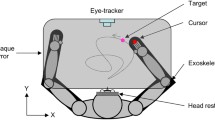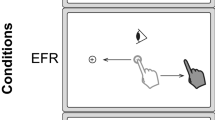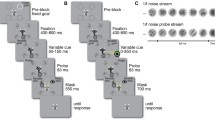Abstract
In a task requiring an optimal hand pointing (with regards to both time and accuracy) at a peripheral target, there is first a saccade of the eye within 250 ms, followed 100 ms later by the hand movement. However the latency of the hand movement is poorly correlated with that of the eye movement. When the peripheral target is cut off at the onset of the saccade, there is no correlation between the error of the gaze position and the error of the hand pointing. This suggests an early parallel processing of the two motor outputs. The duration of hand movement does not change significantly when subjects either see or not see their hand (closed or open loop). In the open loop situation, the undershoot of the hand pointing increases with target eccentricity, whatever the subjects are allowed or not to do a saccade toward the target. It suggests that the encoding of eye position by itself is a poor index for an accurately guided movement of the hand.
Similar content being viewed by others
References
Adams, J.A.: A closed loop theory of motor learning. J. Mot. Behav. 3, 111–149 (1971)
Bartz, A.E.: Eye movement latency, duration and response time as a function of angular displacement. J. Exp. Psychol. 64, 318–324 (1962)
Bauer, J.A., Woods, G.D., Held, R.: A device for rapid recording of positioning responses in two dimensions. Behav. Res. Methods Instrum. 4, 157–159 (1969)
Becker, W., Fuchs, A.F.: Further properties of the human saccadic system: eye movements and correction saccades with and without visual fixation points. Vision Res. 9, 1247–1258 (1969)
Becker, W., Jürgens, R.: Saccadic reactions to double step stimuli: evidence for model feedback and continuous information uptake. In: Basic mechanisms of ocular motility and their clinical implications, pp. 519–524. Lennerstrand, G., Bach y Rita, P. (eds.) Oxford, New York: Pergamon Press 1975
Beeler, G.W.: Stochastic processes in the human eye movement control system. Phd thesis, California Institute of Technology 1965
Berlucchi, C., Heron, W., Hyman, R., Rizzolatti, C., Umilta, C.: Simple reaction times of ipsilateral and contralacteral hand to lateralized visual stimuli. Brain 94, 419–430 (1971)
Brown, J.S., Knauft, E.B., Rosenbaum, G.: The accuracy of positioning reactions as a function of their direction and extent. Am. J. Psychol. 61, 167–182 (1948)
Buisseret, P., Maffei, L.: Extraocular proprioceptive projections to the visual cortex. Exp. Brain Res. 28, 421–426 (1977)
Conti, P., Beaubaton, D.: Utilisation des informations visuelles dans le contrôle du mouvement: Étude de la précision des pointages chez l'homme. Trav. Hum. 39, 19–32 (1976)
Craik, K.H.W.: Theory of the human operator in control systems. I. The operator as an engineering system. Br. J. Psychol. 38, 56–61 (1947)
Davis, R.: The human operator as a single channel information system. Quart J. Exp. Psychol. 9, 119–129 (1957)
Echallier, J.F., Pernier, J., Prablanc, C.: Système de pilotage de stimulations et de recueil de paramètres relatifs à des réponses motrices. Int. J. Bio-Med. Comput. 9, 341–352 (1978)
Fitts, P.M.: The information capacity of the human motor system in controlling the amplitude of movement. J. Exp. Psychol. 47, 381–391 (1954)
Glencross, D.J.: Control of skilled movements. Psychol. Bull. 84, 14–29 (1977)
Granit, R.: Constant errors in the excecution and appreciation of movement. Brain 95, 649–660 (1972)
Hallett, P.E., Lightstone, A.D.: Saccadic eye movements towards stimuli triggered by prior saccades. Vision Res. 16, 99–106 (1976)
Held, R., Gottlieb, N.: Technique for studying adaptation to disarranged hand-eye coordination. Percept. Mot. Skills 8, 83–86 (1958)
Helmholtz, H.: Optique physiologique. Paris: Masson 1867.
Hick, W.E.: The discontinuous functioning of the human operator in pursuit tasks. Quart. J. Exp. Psychol. 1, 36–51 (1948)
Holst, E., Mittelstaedt, H.: Das Reafferenzprinzip (Wechselwirkungen zwischen Zentralnervensystem und Peripherie). Naturwissenschaften 37, 464–476 (1950)
Howarth, C.I., Beggs, W.D.A.: The relationship between speed and accuracy of movement aimed at a target. Acta Psychol. 35, 207–218 (1971)
Knight, A.A., Dagnall, P.R.: Precision of movements. Ergonomics 10, 321–330 (1967)
Lennie, P., Sidwell, A.: Saccadic eye movements and visual stability. Nature 275, 766–768 (1978)
Mateeff, S.: Saccadic eye movements and localization of visual stimuli. Percept. Psychophys. 24, 215–224 (1978)
Matin, L., Matin, E.: Visual perception of direction and voluntary saccadic eye movements. Bibl. Ophthal. 82, 358–368 (1972)
McKay, D.M.: Theoretical models of space perception. In: Aspects of the theory of artificial intelligence. Muses, C.A. (ed.). New York: Plenum Press 1962
McKay, D.M., Mittelstaedt, H.: Visual stability and motor control (reafference revisited). In: Cybernetics and bionics. Keidel, W.D. (ed.). Munich: Oldenbourg 1974
Megaw, E.D.: Possible modification to a rapid ongoing programmed manual response. Brain Res. 71, 425–442 (1974)
Merton, P.A.: Absence of consicious position sense in the human eyes. In: The oculomotor systems. Bender, M.B. (ed), pp. 314–320. New York: Harper&Row 1964
Navas, F., Stark, L.: Sampling or intermittency in hand control system dynamics. Biophys. J. 8, 252–302 (1968)
Polit, A., Bizzi, E.: Characteristics of motor programs underlying arm movements in monkeys. J. Neurophysiol. 42, 183–194 (1979)
Prablanc, C., Jeannerod, M.: Continuous recording of hand position in the study of complex visuomotor tasks. Neuropsychologia 11, 123–125 (1973)
Prablanc, C., Jeannerod, M.: Latence et précision des saccades en fonction de l'intensité, de la durée et de la position rétinienne d'un stimulus. Rev. E.E.G. Neurophysiol. 3, 484–488 (1974)
Prablanc, C., Jeannerod, M.: Corrective saccades: dependence on retinal reafferent signals. Vision Res. 15, 465–469 (1975)
Prablanc, C., Echallier, J.F., Massé, D.: Error correcting mechanisms in large saccades. Vision Res. 18, 557–560 (1978)
Rabitt, P., Rodgers, B.: What does a man do after he makes an error? An analysis of response programming. Q. J. Psychol. 29, 727–743 (1977)
Robinson, D.A.: Models of the saccadic eye movement control system. Kybernetik 14, 71–83, (1973)
Sherrington, C.S.: Observations on the sensual role of the proprioceptive nerve supply of the extrinsic eye muscles. Proc. R. Soc. 64, 120–121 (1918)
Skavenski, A.A.: Extraretinal correction and memory for target position. Vision Res. 11, 743–746 (1971)
Skavenski, A.A.: Inflow as a source of extraretinal eye position information. Vision Res. 12, 221–229 (1972)
Skolnick, A.: Stability and performance of manual control systems. IEEE Trans. Hum. Factors Electron. 7, 115–124 (1966)
Sperry, R.W.: Effect of 180° rotation of the retinal field in visuomotor coordination. J. Exp. Zool. 92, 263–279 (1943)
Stark, L., Iida, M., Willis, P.A.: Dynamic characteristics of the motor coordination system in man. Biophys. J. 1, 279–300 (1961)
Taub, E., Goldgerg, I.A., Taub, P.: Deafferentation in monkeys pointing at a target without visual feedback. Exp. Neurol. 46, 178–186 (1975)
Van Der Staak, C.: Intra and interhemispheric visual motor control of human arm movements. Neuropsychologia 13, 439–448 (1975)
Vince, M.A.: The intermittency of control movements and psychological refractory period. Br. J. Psychol. 38, 149–157 (1948)
von Holst, E., Mittelstaedt, H.: The principle of reafference. In: Perceptual processing pp. 41–47. Dodwell, P.C. (ed.). New York Appleton Century Croft 1971
Welford, A.T.: The measurement of sensory motor performances: survey and reappraisal of twelve years progress. Ergonomics 3, 189–230 (1960)
Wheeless, L., Jr., Boynton, R., Cohen, G.: Eye movement responses to step and pulse step stimuli. J. Opt. Soc. Am. 56, 956–960 (1966)
Wiesendanger, M.: Programmation centrale et contrôle reflexe des mouvements. In: Du contrôle moteur à l'organisation du geste. Hecaen, H., Jeannerod, M. (eds.), pp. 73–83. Paris: Masson 1978
White, C.T., Eason, C., Bartlett, N.R.: Latency and duration of eye movements in the horizontal plane. J. Opt. Soc. Am. 52, 210–213 (1962)
Woodworth, R.S.: The accuracy of voluntary movement. Psychol. Rev. Monogr. Suppl. 3, 3 (1899)
Young, L.R., Stark, L.: Variable feedback experiments testing a sampled data model for eye tracking movements. IEEE Trans. Hum. Factors Electron., H.F.E. 4, 38–51 (1963)
Author information
Authors and Affiliations
Rights and permissions
About this article
Cite this article
Prablanc, C., Echallier, J.F., Komilis, E. et al. Optimal response of eye and hand motor systems in pointing at a visual target. Biol. Cybernetics 35, 113–124 (1979). https://doi.org/10.1007/BF00337436
Received:
Issue Date:
DOI: https://doi.org/10.1007/BF00337436




